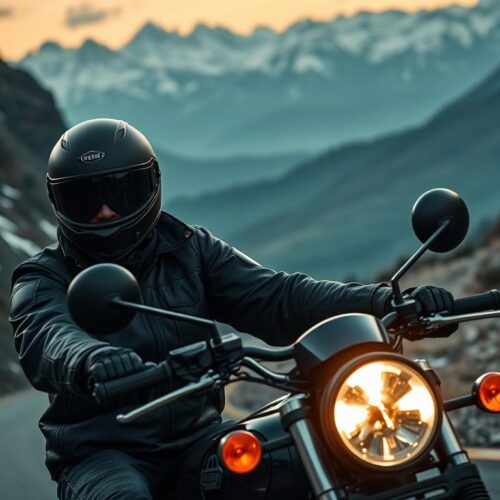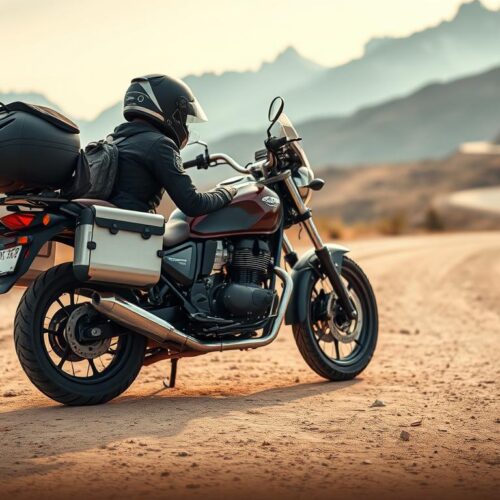Long, straight stretches on a trip can get boring fast. Riding from Central Ontario to Nova Scotia or across U.S. interstates tests your focus and mood. Knowing how to avoid boredom is key.
See your ride as a series of tasks. Planning your fuel is crucial. Some bikes, like Harley-Davidson Road Glides, have a steady range until it drops fast. Map your stops and always fill up to avoid surprises.
Pack wisely. Use a good tank bag for essentials like ear plugs, sunscreen, and maps. Keep snacks and tools within reach. These small steps help you stay focused and avoid boredom.
Set goals beyond just the miles. Add scenic routes, events, or maintenance checks to your trip. Many riders take on Iron Butt challenges or use trips to test their bikes. This turns a boring ride into an adventure and a confidence builder.
Understanding Boredom on the Road
Riding across flat plains or long highways in Manitoba or Saskatchewan can be dull. The same views and lack of landmarks make the ride feel like a drag.
Traveling on interstates can also be boring. The same traffic, rest stops, and endless miles make it feel like you’re stuck in a loop. Some riders see it as a challenge, while others find it draining.
Physical discomfort can make boredom worse. Cold mornings, a hard seat, or cramped riding can make you tired faster. When you’re tired, it’s hard to stay focused and enjoy the ride.
Changing your view can help. Seeing new sights like rock formations, beaches, or trees can keep your attention. Without these, you have to work harder to stay interested.
Telling stories can make the ride more exciting. Creating a story or setting small goals can give you a sense of purpose. Editing your trip videos with music can make you feel like you’re part of the journey.
Here are some quick tips to fight boredom: change your seat or position every hour, set small visual goals, and switch your music. These can help keep you alert and focused.
| Trigger | Effect on Rider | Quick Fix |
|---|---|---|
| Uniform scenery (plains, straight highway) | Monotony, drifting attention | Set visual targets every 10 miles |
| Unremarkable traffic | Loss of engagement, autopilot | Practice mindful scanning and lane changes |
| Physical discomfort | Faster fatigue, irritability | Adjust saddle, use heated gear, stretch stops |
| Lack of environmental variety | Extended boredom on long routes | Plan scenic detours or timed breaks |
| No narrative or purpose | Riding feels pointless | Create micro-goals or record moments |
Preparing for the Journey
Packing light makes the journey easier. Use a tank bag for quick access to essentials like ear plugs and gum. A clear map holder helps you stay on track without stopping.
Learn your bike’s quirks before you hit the road. Many Harley owners face fuel gauge issues, so plan stops early. Note down gas stations that are open 24/7 to avoid dark searches.
Make sure you and your bike are comfortable. Choose a saddle that fits well and wear Performance UnderGear PUG undershirts for cold starts. Carry neoprene gloves for chilly weather and organize your panniers for easy access to snacks.
Develop simple pre-ride routines to reduce stress. Use a checklist and keep a trip log with odometer entries and fuel stops. These habits let you enjoy the scenery and the ride.
If you want to document your trip, bring compact photo and video gear. Schedule time for editing to keep your daily miles realistic. This balance makes riding long roads enjoyable.
Engaging Your Senses
Look for small details in the landscape to break the monotony. A rock in the Canadian Shield, sand beaches on Lake Superior, or a town sculpture in Massey can shift your focus. Stopping to touch cold water or feel a change in temperature brings you back to the moment.
Make sure your body is comfortable to avoid distractions. Wear warm base layers, quality gloves, and water-resistant boots. Adjusting to the weather helps you stay focused on the road.
Turn stretches into memorable moments by linking scenery with music and memories. Play a favorite song, recall a road trip memory, or note changes in the atmosphere. These actions add depth and fun to your journey.
Keep a journal or voice memo app handy. Writing a sentence about what you see or recording a quick thought can turn a dull mile into a memorable scene. This habit sharpens your senses and keeps you engaged.
Do short sensory checks every 30–45 minutes. Look for temperature changes, feel the pavement, and listen for new sounds. This habit keeps boredom at bay and makes your journey enjoyable.
Audiobooks and Podcasts
On long rides, spoken-word entertainment can turn dull moments into exciting ones. With a tank bag for maps and a simple GPS, you can listen to audiobooks and podcasts. This makes the journey more enjoyable.
For long rides, pick stories or non-fiction that keeps you interested. Choose something that matches your mood and focus. This helps you stay engaged without getting distracted.
Before you start, test your helmet’s communication system and battery. Reliable connections mean less interruption. This lets you enjoy your ride without worrying about technical issues.
Travelogues and creative non-fiction can make your journey feel like a story. Listening to writers and documentarians can turn routine miles into exciting chapters. This is great for fighting boredom on the road.
Plan your ride with playlists of podcast seasons and audiobook chapters. Break points at episode ends make rest and refueling easier. This is especially helpful on long rides.
| Device | Best for | Battery Life | Notes |
|---|---|---|---|
| Smartphone with offline apps | Wide library, podcasts, audiobooks | 8–12 hours with power bank | Download episodes; use airplane mode to save battery |
| Dedicated MP3 player | Long battery life, simple controls | 20+ hours | Pair with helmet system for stable playback |
| Bluetooth helmet headset | Hands-free listening | 6–15 hours | Check fit and audio clarity at speed |
| Power bank | Extended rides, emergency backup | Varies by capacity | Choose rugged, high-capacity models for multi-day trips |
Music to Motivate
Use music to mark phases of your route so long miles feel intentional. Play upbeat tracks for midday straight runs. Choose calmer songs for scenic stretches like Lake Superior or evening approaches. A good tank bag keeps your device handy, avoiding fumbling while riding.
Match playlists to your riding rhythm to cut through motorcycle boredom. Set up “sweep” playlists timed to distance goals. This way, each segment ends with a satisfying musical cue. Check helmet audio quality and keep volume at a level that still lets you hear traffic and radio chatter.
Curate playlists by duration so you do not need to change tracks often. Organize sets for 30, 60, and 120-minute blocks. Label them clearly on your phone or device. This structure reduces distraction and keeps road trip fun flowing between stops.
Think like a video editor and score your ride to create emotional lifts. Pair cinematic songs with open stretches. Ambient tracks are good for sunrise miles, and driving rock for tunnels or bridges. The right soundtrack turns monotony into momentum and helps you stay present on long straightaways.
Riding Partners: Make It Social
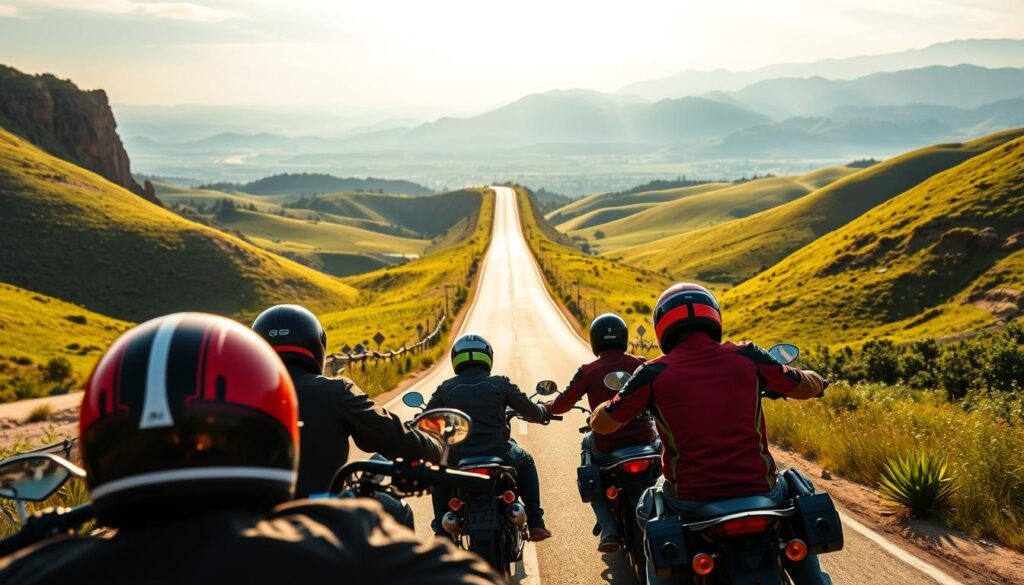
When you ride with others, long roads don’t feel so lonely. Stopping at Wawa or checking out roadside sculptures becomes fun. It’s all about sharing the experience.
Having a partner means you can catch mistakes before they become big problems. They help you spot wildlife and check your gear. This keeps you focused and less bored.
Competition adds excitement to the ride. You might aim to finish a scenic route or keep up with someone. These goals make the journey more meaningful.
Sharing tasks makes the ride easier. You can take turns navigating and handling fuel stops. This helps you stay fresh during long rides.
Sharing your adventures online connects you with others. Posting on Instagram or YouTube can build a community. It makes the miles feel worth it.
Going on group rides opens up new places to explore. You learn about safe stops and great diners. These tips keep the ride interesting and safe.
Taking Breaks: A Must!
Short, planned stops keep you safe and sharp. It’s important to plan fuel stops, especially when stations close early. If your bike has a half-tank rule, refuel earlier than usual.
Use a tank bag map viewer to track your progress. This helps avoid long detours and ensures you refuel when needed. Many Wawa locations close their pumps at odd hours in rural areas.
Breaks fix physical issues fast. Wet boots, chilled hands, stiff necks, or a loose chain can become big problems if ignored. Warm up at a coffee shop or small-town diner to rehydrate and share a quick story with locals.
Breaks also cut fatigue and make long days feel manageable. This supports staying entertained on the road.
Use downtime creatively. Edit a short clip, write a few lines in a travel journal, or snap photos. These actions turn routine work into road trip fun and create memories to revisit later.
Mix practical checks with small pleasures. Inspect tires and fluids, then reward yourself with a stretch, a muffin, or five minutes of a favorite podcast. If you want lodging that suits a rider, scan resources like motorcycle-friendly lodging on your break and book with confidence.
Plan stops roughly every 60–90 minutes on long, straight stretches. Frequent, brief breaks are better than one long delay. This habit eases monotony and keeps your focus sharp, helping with dealing with boredom on the road and turning endurance into road trip fun.
Creative Mind Games
Long straight miles can make you lose focus quickly. To fight motorcycle boredom, turn the scenery into mini-challenges. Count sculptures or murals as you pass through towns like Massey. Keep track of lakes on stretches that remind you of Muskoka.
Watching for granite cuts and rock outcroppings makes the ride exciting. It sharpens your observation skills.
Navigation puzzles are fun if you enjoy planning. Map out fuel stops to save time and distance. Try different routes to see which is faster or shorter.
Set safe time trials for throttle inputs or aim to keep a certain MPG. These exercises keep your mind sharp while riding long roads.
Writing down your thoughts turns repetition into creative work. Record short voice memos, jot down notes at rest stops, or write micro-stories about what you see. Later, editing these snippets can create content for social media or a personal log.
Photography on the Go
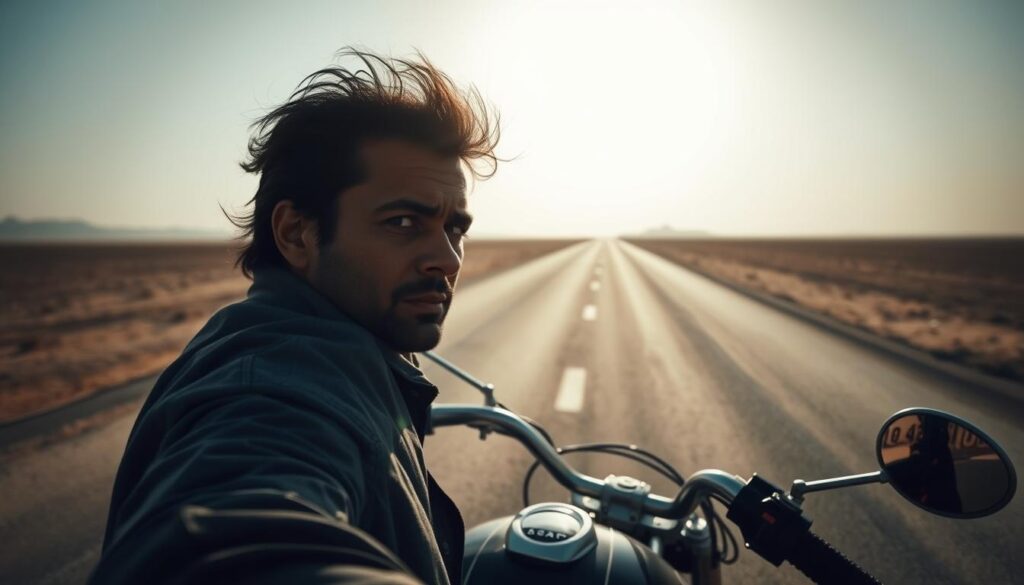
Look for unique roadside moments to make your trip exciting. Find steel sculptures in Massey, sand beaches along Lake Superior, or dramatic rock cuts near Nipigon. A lone bear crossing near Nipigon is also a great sight.
Use quick, safe stops and a clear map holder to keep your ride smooth. This way, you can enjoy the journey without interruptions.
Keep a compact camera or smartphone ready and secure. This prevents fumbling in cold or wet weather. A small tripod or a chest-mounted GoPro helps capture steady shots while moving.
These images and clips create a visual story that keeps you entertained. Frame short sequences that match changing light and weather. Scenes like fog over cornfields or sudden rain on parking lots add drama.
Make photography a part of your riding routine to avoid boredom. Set small goals like five shots of roadside art or three motion-blur highway frames. This purpose keeps you alert and turns miles into a story you can edit later.
Embracing Technology
Use tools like MapQuest and offline maps to plan your route. You can estimate travel times for places like Ontario to Kenora. Adjust your plans if traffic or weather changes. Always carry paper maps and a tank bag map holder as a backup.
Keep an eye on your fuel range. Different bikes have different fuel gauge quirks. Note how far you can go on a tank during your first ride. Use trip-logging apps to record your odometer and stops. This helps with planning future rides.
Get a helmet communication system from Sena or Cardo for music and calls. These systems help you stay connected on long rides. Don’t forget power banks and charge cables for your devices.
Organize your essentials for easy access. Store snacks, rain gear, and a toolkit where you can reach them without stopping. Having charged devices and visible storage makes the ride safer and less boring.
Set aside time each day for media work if you’re documenting your rides. Editing videos and photos takes time. Use social platforms to share your clips and get feedback. This turns your rides into shared experiences.
Use trip apps and route planners to set small goals. Aim for scenic spots or diner stops. Breaking your ride into smaller goals makes it more enjoyable and keeps you focused.
Enjoying the Journey’s Narrative
Make a long ride exciting by setting clear goals for your trip. Mix things up by combining different activities, like a Lake Superior loop with a bike event in Alberta. This creates a story with ups and downs, ending in a satisfying conclusion.
Mark important moments, like ending the day in Wawa or finding a renewed main street. These breaks add variety and depth to your journey.
Use long rides to test your bike after maintenance. See each challenge, like overheating or a stiff fork, as a chance to grow. Keep track of these moments in a notebook or app. This helps you see your progress and stay entertained.
Plan short recording sessions to capture your feelings and the local atmosphere. Follow vloggers’ tips: match your clips to music and keep a steady pace. Even a short voice note or a two-minute clip can turn into a compelling story.
Make a checklist for what to record each day. Include a mechanical check, a personal reflection, and a local interaction. This structure helps you gather interesting material and makes the journey more varied and fun.
| Story Beat | What to Capture | Why It Helps |
|---|---|---|
| Departure | Pre-ride prep, packing, first-mile emotions | Sets tone and stakes for your narrative |
| Midday Turn | Scenic pull-offs, short reflections, sound bites | Breaks long stretches and keeps you engaged |
| Mechanical Challenge | Quick notes on repairs, checks after maintenance | Introduces tension and shows resilience |
| Local Color | Conversations with shop owners, diners, signage | Adds human interest and anchors place |
| Evening Wrap | Camp setup, sunset shots, brief recap | Provides closure for each day and fuels memory |
Building a Personal Riding Routine
Set clear routines for departures to save time and get into a rhythm. Pack light and leave a bit later if it reduces stress. Keep essentials in a tank bag and map holder for easy navigation and fewer stops.
Make refueling a habit by knowing your bike’s tank range. Top off before the gauge drops too low. Plan midday stops for fuel, food, and rest. This pattern makes long stretches feel manageable and reduces boredom.
Create a quick pre-ride checklist: tires, fluids, lights, and chain. Follow it every time. After maintenance, take a short shakedown ride to confirm fixes. Use longer rides to spot issues that only appear under load. These habits protect you and give purpose to each mile.
Keep a trip log with odometer notations and scheduled hydration breaks. Pick reliable snack locations and set predictable clothing layers. A steady routine for breaks and gear changes reduces decision fatigue and eases motorcycle boredom.
Build a content routine to make days feel productive. Record brief voice notes, select a few daily photos, or do short edits each evening. Small creative habits reward you between miles and help with dealing with boredom on the road by turning downtime into progress.
Use this outline as a starting point: pre-ride checks, predictable refuel stops, hydration and snack timing, clothing layers, and quick post-ride notes. Keep each habit simple and repeatable. Over time, a consistent routine will transform riding long roads from a chore into a deliberate, enjoyable practice.
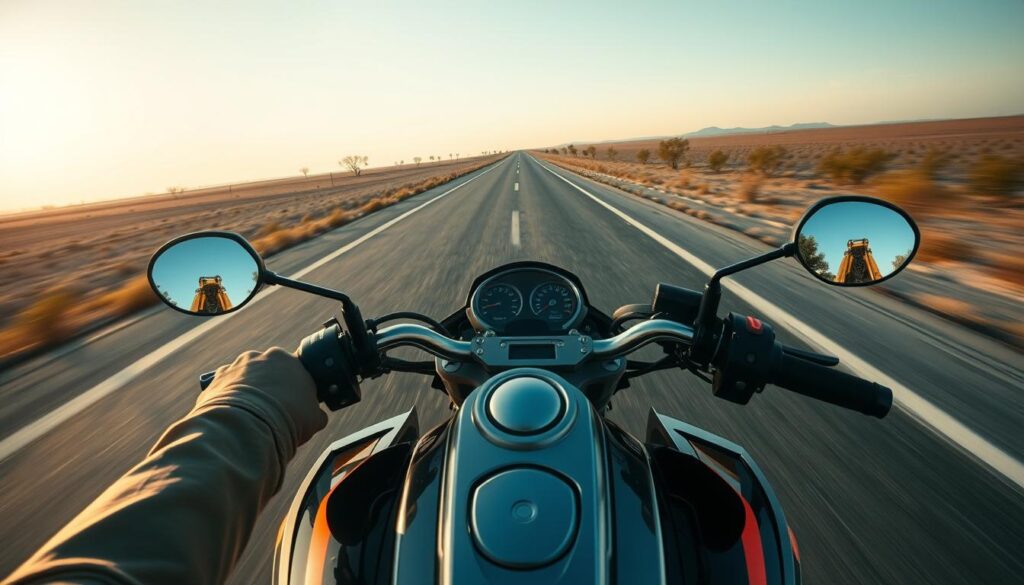
Adapting to Weather Conditions
Weather can change your plans and mood. Heavy storms, sudden rain, or strong winds might make you stop or find shelter. Use these breaks to update your playlist, check your route, or read a quick checklist like the one at motorcycle trip preparation checklist.
Cold spots near lakes and headwinds can affect your fuel use. A headwind in Manitoba cut fuel efficiency from 57 mpg to about 44 mpg for some. Keep an eye on wind changes to enjoy your ride more.
Discomfort makes long rides feel even longer. Cold, wet, and hail can drain your energy. Wear layers, waterproof shoes, and have a quick change plan. Small routines help manage boredom on the road.
Wearing rain gear and being flexible keeps you safe and comfy. If storms are intense, wait them out. A short delay can save your bike and mood. When the sun comes out, you’ll enjoy fresh air and clear views.
Use weather changes to your advantage. Fog, sunlight, and raindrops on chrome make great photos. Taking photos or changing your playlist can turn bad weather into fun and keep you entertained.
Plan for layers, waterproof storage, and flexible stops. These steps help you stay adaptable and focused. It makes dealing with boredom safer and more enjoyable.
Finding Inspiration in Your Surroundings
Look for small-town charm and roadside art to beat motorcycle boredom. A weathered steel sculpture or a colorful diner can make a long ride feel shorter. Geological wonders like the Canadian Shield or Superior’s beaches offer new views without a big detour.
Track moments that turn miles into memories. Celebrate reaching a thousand miles, warming up in a Sheetz after cold winds, or seeing how a recent tune-up holds up. These small victories make the journey fun and keep you entertained.
Notice wildlife and local stories to spark curiosity. Seeing prairie dogs, antelope, or an old mine town can lead to new questions and paths. When you see a sign about a closed mine or prospecting, pause and think about the lives there.
Share your finds with other riders. A short video of a mural or a note about a great overlook can excite friends or forum readers. Sharing boosts the fun and cuts through boredom.
Use simple rituals to mark each day. Checklists, a noon photo, or a quick check on your bike become landmarks on a straight road. These rituals keep you in the moment, make small finds important, and keep the journey exciting even when the view is the same.
Wrapping Up Your Trip
As you arrive at your last stop, take a moment to reflect on the day. Think about your fuel planning successes and challenges. Did you need to go back to a Wawa or almost run out of gas? Writing down where you refueled and how far you went helps for future trips. It also reduces stress and keeps you entertained on the road.
Go through the end-of-ride checklist to check on your bike and yourself. If you had a service recently, see how the bike performed over long distances. Check if your saddle, PUG underlayers, and gloves are comfortable. Also, adjust your tank bag or pannier setup for easier access next time. These small changes boost your confidence and make future rides better.
Lastly, share the best parts of your day. Save photos, voice notes, and short videos that capture the essence of your journey. Sharing your adventure makes it more meaningful and keeps you excited for the next trip. Looking back or sharing these moments makes planning the next ride part of the fun.


